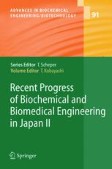Search
Search Results
-
Lentiviral Vectors
We review the use of lentiviral vectors in current human gene therapy applications that involve genetic modification of nondividing tissues with...
-
Self-Assembling Nanopeptides Become a New Type of Biomaterial
Combining physics, engineering, chemistry and biology, we can now design, synthesize and fabricate biological nano-materials at the molecular...
-
Modulating Extracellular Matrix at Interfaces of Polymeric Materials
As extracellular matrices (ECM) closely interact with cells in living tissues and, through this, influence essentially any aspect of life...
-
Plasmid Vaccines and Therapeutics: From Design to Applications
In the late 1980s, Vical and collaborators discovered that the injection into tissues of unformulated plasmid encoding various proteins resulted in...
-
Adeno-associated Virus as a Gene Therapy Vector: Vector Development, Production and Clinical Applications
Adeno-associated virus (AAV) has emerged as an attractive vector for gene therapy. AAV vectors have successfully been utilized to promote...
-
Role of subcytotoxic stress in tissue ageing
Most commonly stress-induced premature senescence (SIPS) is defined as the long-term effects of subcytotoxic stress on proliferative cell types,...
-
Mammalian and bird aging, oxygen radicals, and restricted feeding
In this chapter, the relationship of aging with oxidative stress is reviewed. Endogenous tissue antioxidants do not determine aging because they...
-
Mitochondria, metabolism, and aging in yeast
Quantitative and qualitative changes in metabolism take place when the lifespan is extended in yeast either by genetic or nutritional manipulation....
-
Yeast as a model for ageing and apoptosis research
Apoptosis is a form of programmed cell death with a crucial role in health and disease in metazoans. Recent findings demonstrate the existence of an...
-
Large-Scale Production of Hairy Root
Many products of interest are synthesized in organized tissues, but not formed in suspension or callus culture. Therefore, most attention has been...
-
Enzymatic Synthesis of Structured Lipids
Structured lipids (SLs) are defined as lipids that are modified chemically or enzymatically in order to change their structure. This review deals...
-
Spinal Cord Regeneration
Repairing the damaged spinal cord has for a long time eluded neuroscientists. Few other achievements in neuroscience would have such a tremendous...
-
The function of Sec1/Munc18 proteins – Solution of the mystery in sight?
Members of the Sec1/Munc18 (SM) protein family form a central part of the machinery responsible for transport vesicle docking and fusion. Their...
-
Phosphoinositides and membrane traffic in health and disease
The phosphorylated derivatives of phosphatidylinositol (PtdIns) are collectively known as the polyphosphoinositides (PIs) and they were originally...
-
Peripheral Nerve Regeneration
The nerve chamber model has dominated the experimental study of peripheral nerve (PN) regeneration with animal models as well as in several clinical...
-
Regulating membrane curvature
Membranes of living cells are subject to a variety of shape changes. Membrane deformation is essential for cell division, locomotion, organelle...
-
Effect of annealing temperature on the optoelectrical synapse behaviors of A-ZnO microtube
Optoelectronic synapses with fast response, low power consumption, and memory function hold great potential in the future of artificial intelligence...

-
Cell-cell contact-dependent secretion of large-extracellular vesicles from EFNBhigh cancer cells accelerates peritoneal dissemination
BackgroundLarge non-apoptotic vesicles released from the plasma membrane protrusions are classified as large-EVs (LEVs). However, the triggers of LEV...

-
Biophysical characterization of the phase separation of TDP-43 devoid of the C-terminal domain
BackgroundFrontotemporal lobar degeneration with ubiquitin-positive inclusions (FTLD-TDP), amyotrophic lateral sclerosis (ALS) and limbic-predominant...

-
Effect of α7 nAChR-autophagy axis of deciduous tooth pulp stem cells in regulating IL-1β in the process of physiological root resorption of deciduous teeth
AbstractPhysiological root resorption of deciduous teeth is a normal phenomenon occurring during the developmental stages of children. Previous...

